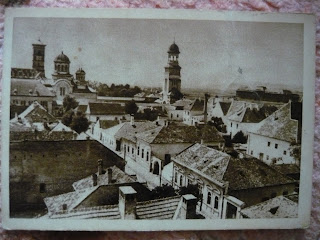Alba Iulia (Hungarian: Gyulafehérvár, German: Karlsburg or Weißenburg, Latin: Apulum in the Roman period, later Alba Iulia; Ottoman Turkish: Erdel Belgradı) is a city in Alba County, Transylvania, Romania with a population of 58,681, located on the Mureş River. Since the High Middle Ages, the city has been the seat of Transylvania's Roman Catholic diocese. Between 1541 and 1690 it was the capital of the Eastern Hungarian Kingdom and the latter Principality of Transylvania. Alba Iulia is historically important for Romanians, Hungarians and Transylvanian Saxons.
Fortress' walls. 1958 used card. Written and stamped.
The main historical area of Alba Iulia is the Upper Town region, developed by Charles VI of the Holy Roman Empire in honour of whom the Habsburgs renamed the city Karlsburg. The fortress, with seven bastions in a stellar shape, was constructed between 1716 and 1735, by two fortification architects of Swiss origin. The first one was Giovanni Morandi Visconti, who constructed two old Italian stile bastions, followed by Nicolaus Doxat de Demoret, nicknamed "Austrian Vauban". The two architects radically transformed (after 1720) the medieval fortress shaped by the former Roman Castrum into a seven-bastion baroque fortress, developing Menno van Coehorn's new Dutch system, of which the fortress of Alba Iulia is the best preserved example.



No comments:
Post a Comment